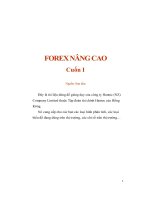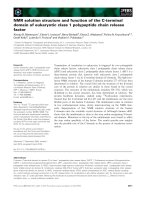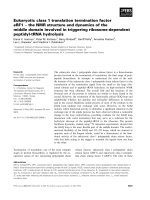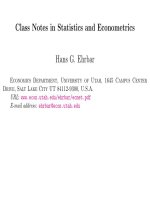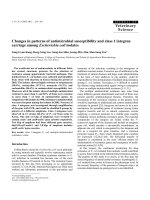Class 1 FOREX ER
Bạn đang xem bản rút gọn của tài liệu. Xem và tải ngay bản đầy đủ của tài liệu tại đây (3.07 MB, 34 trang )
PUBLIC AND MONETARY POLICY
#1. Foreign Exchange Market and the Exchange Rate
By Ph.D. Nguyen Cam Nhung
1
Outline
●Exchange rate
●Foreign exchange market
●Equilibrium in the foreign exchange rate
●The effect of changing interest rates on
the current exchange rate
●The effect of changing expectations on
the current exchange rate
2
The Exchange Rate
●Definition:
◦ The price of the foreign currency in terms of the
domestic currency.
◦ E.g) Exchange rate of VND vis-à-vis USD
⚫USD 1 = VND 20850 (E = 20850)
●Exchange rate plays a central role in international
transactions
◦ By using exchange rates, we can compare the prices of
goods and services produced in different countries.
The Exchange Rate (cont’d)
●Consider the case of VND/USD EXR:
◦ E = Exchange rate of VND against USD.
◦ E = 20.850 (VND/USD) (July 31, 2012)
●Appreciation of VND against USD:
◦ Decrease in E (20.850
19.000).
●Depreciation of VND against USD:
◦ Increase in E (20.850
22.000).
4
The Exchange Rate (cont’d)
5
Impact of Exchange Rate Changes
on Trade
●Example 1:
◦ Vietnam imports a laptop from Japan.
◦ The price of a Sony Vaio laptop is 1000 USD.
◦ The initial EXR is 20.850 VND/USD
●The VND price of a laptop before and after
appreciation of VND (20.850 18.000) is:
◦ (1000 USD) x (20.850 VND/USD) = 20.850.000 VND
◦ (1000 USD) x (18.000 VND/USD) = 18.000.000 VND
●Effect of VND appreciation:
◦ Import price from Japan will be cheaper in terms of VND.
6
Impact of Exchange Rate Changes
on Trade (cont’d)
●Example 2:
◦ Vietnam exports rice to Philippines.
◦ The price of one ton of rice is 10.000.000 VND.
◦ The initial EXR is 20.850 VND/USD
●The VND price of one ton of rice before and after
appreciation of VND (20.850 18.000) is:
◦ (10.000.000 VND) / (20.850 VND/USD) = 479,6 USD
◦ (10.000.000 VND) / (18.000 VND/USD) = 555,5 USD
●Effect of VND appreciation:
◦ Export price to Philippines will be higher in terms of USD.
7
Impact of Exchange Rate Changes
on Trade (cont’d)
●Summary:
◦ When VND depreciates, Philippines residents find that
Vietnamese products are cheaper and Vietnamese
residents find that Japanese products are more
expensive. (in case that USD is used in trading)
◦ An appreciation of VND has opposite effects.
Philippines residents pay more for the Vietnamese
products and Vietnamese consumers pay less for the
Japanese products.
8
The Foreign Exchange Market
●Forex Market:
◦The market in which
currency trades take place.
international
◦A network of banks and other financial
institutions, liked by telephone and
computer, that buy and sell currencies.
10
The Foreign Exchange Market
(cont’d)
●Major participants:
◦ Commercial banks: are at the center of the foreign
exchange market because almost every sizable
international transaction involves the debiting and
crediting of accounts at commercial banks in various
financial centers.
◦ Corporations: with operations in several countries
frequently make or receive payments in currencies other
than that of the country in which they are headquartered.
11
The Foreign Exchange Market
(cont’d)
●Major participants:
◦ Nonbank financial institutions: to offer their customers
services involving foreign exchange transactions.
◦ Central banks: are the most regular official participants
who intervene in the foreign exchange rate in order to
achieve macroeconomic objectives such as fighting
inflation and market stability.
12
Characteristics of the Market
● Forex trading takes place in many financial centers such as
London (the largest market), New York, Tokyo, Frankfurt, and
Singapore.
● The amount of forex transactions in major markets:
◦
◦
◦
◦
USD 590 billion per day (April 1989)
USD 1.2 trillion per day (April 2001)
USD 1.88 trillion per day (April 2004)
USD 3.98 trillion per day (April 2010) (Bank for Int’l Settlements)
● The amount of exports plus imports:
◦ USD 12.5 trillion per day (2001, World total)
◦ USD 1.91 trillion per day (2001, US total)
● The US dollar = vehicle currency:
◦ The US dollar is widely used in international transactions that do not
involve the US actors.
13
Functions of the Forex Market
●Serve the international trade activities
●Facilitate international capital movements
●Determine exchange rates by supply and
demand forces
●The place where Central Banks directly
intervene in exchange rates
●Provide trading environment and hedging
instruments
14
Exchange Rate Classifications
● Bid rate: is the rate at which the quoting bank is ready to buy the
commodity currency.
● Offer (or Ask) rate: is the rate at which the quoting bank is ready to
sell the commodity currency.
● Spot rate is the rate formed directly via supply and demand forces
in the Forex market.
● Derivative rate: include rates used in the Forward, Swap, Future,
and Options. They are not directly formulated via the supply and
demand forces in the Forex market but calculated from the available
variables in the market such as spot rates, interest rates of two
currencies, etc. Derivative rates are terms rates. The exchange rate
is contracted today, but the value date is after at least three working
days.
15
Exchange Rate Classifications
(cont’d)
● Opening rate: is the rate used for the first transaction of the
business day.
● Closing rate: is the rate used for the last transaction of the
business day. Normally, the rates used for all contracts
conducted in a day are not published, but only the closing
rate is. Today’s closing rate is not opening rate of the next
business day.
● Cross rate: is the rate of two currencies derived from the
third one (or medium currency).
● Transfer rate: is the rate used for the transactions of the
currencies which are deposited at bank accounts.
16
Exchange Rate Classifications
(cont’d)
● Bank note rate: is the rate used for the cash transactions
such as coins, bank notes, travelers’ cheques and credit
cards. Normally, bank note bid rate is lower and bank note
ask rate is higher than the transfer rate.
● Telegraphic rate: is the rate used for the telegraphictransferred transactions. Nowadays, most of the
transactions are telegraphic-transferred transactions; thus,
the exchange rates quoted at the banks are telegraphictransferred rates.
17
Spot Rates and Forward Rates
● Spot exchange rates:
◦ The forex transactions that take place on the spot.
◦ The value date for a spot transaction (i.e., the date on which we
actually receive the funds) occurs 2 business days after the deal is
made
● Forward exchange rates:
◦ The exchange rate quoted in transactions that specify a value date
further away than 2 days (30 days, 90 days, 180 days, or longer).
◦ Forward and spot exchange rates are not necessarily equal, but do
more closely together (Figure 13-1, p.333 in Krugman & Obstfeld,
2006)
18
Forward Exchange Transactions
● Example:
◦ A Vietnamese company imports a car from the US (the contract date
is April 1st ).
◦ Current exchange rate (April 1st ): USD 1 = VND 20.850
◦ He must pay USD in 30 days to the US exporters
◦ Suppose he expects that VND will depreciate:
USD 1 = VND 20.850 (April 1st )
USD 1 = VND 22.000 (May 1st )
◦ To avoid the exchange rate risk, he can make a 30-day forward
exchange deal with his bank.
19
Equilibrium in the Forex Market
● The Rate of Return:
◦ The percentage increase in value an asset offers over some time
period.
● Equilibrium in forex market:
◦ In equilibrium, deposits of all currencies must offer the same
expected rate of return.
◦ The rate of return on VND assets
R
◦ The rate of return on USD assets:
⚫ R* + (E(e) – E)/E
⚫ The sum of (i) USD interest rate and (ii) the expected rate of
VND depreciation against USD.
20
Equilibrium in the Forex Market
(cont’d)
●Interest Parity Condition:
◦ Expected returns on deposits of any two currencies
are equal when measured in the same currency.
R = R* + [E(e) – E]/E
◦ R: (today’s) VND interest rate
◦ R* : (today’s) USD interest rate
◦ E: (today’s) VND/USD exchange rate
◦ E(e): expected VND/USD exchange rate
21
Start
(time T)
Goal
(time T+1)
(VND interest rate)
RVND = 0.05
(MD1 = (1+ RVND )*MD0
MD0 = VND
10.000.000
(VND/USD Rate)
E0 = 20.000
(MS0 = MD0/E0)
MS0 = USD
500
(Rate of Return on
US Asset in terms of VND)
R$ = 0.1025
MD1 = VND
10.500.000
MVN1 = VND
11.025.000
(VND/USD Rate)
E1 = 21.000
(MVN1 = MS1*E1)
(US interest rate)
RUS = 0.05
(MS1 = (1+ RUS )*MS0
MS1 = USD
525
22
Comparing VND Rates of Return on
VND and USD Assets
23
The Equilibrium Exchange Rate
●How are equilibrium
determined?
exchange
rates
◦ See Figure 13-4 (p.346) in K&O (2006).
◦ Assume that the expected future VND/USD
exchange rate (E(e)) is given
◦ Suppose that interest rates are determined in each
country’s market.
◦ Then, (current) exchange rates always adjust to
maintain interest parity.
24
Figure 13-4: Determination of
Equilibrium VND/USD EXR
EXR
Return on
VND deposits
E2
2
1
E1
3
E3
Expected return on
dollar deposits
R
Rates of
return (in VND
terms)
25



